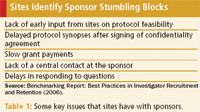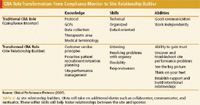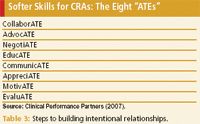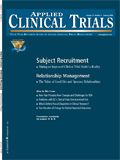Good Site and Sponsor Relationships Pay Off
Applied Clinical Trials
Both parties benefit from intentional friendships, and nowadays CRAs are key to this cordial effort.
To hear sponsors tell it, the complex business of conducting clinical trials is fraught with challenges, perhaps none bigger than the slowdown caused by underperforming investigative sites. From the site's perspective, clinical trials are characterized by demanding protocols, tough deadlines, grant payment problems, and enrollment pressures—difficulties all caused by the sponsor. Each side has been pointing the finger at the other for a long time. But now, with so much at stake, namely patent expirations, intense global competition, and heightened emphasis on safety, there is keen interest in making things better, in listening and learning from each other—essentially building a relationship.

Some sponsors are becoming intentional in their efforts to build relationships with sites, hoping to turn more of them into predictably high performers. They are reaching out to sites to identify the issues they have with sponsors that create stumbling blocks and stall performance (see Table 1). The current thinking is that addressing these issues has tremendous potential for improving outcomes.1 A number of forward-thinking sponsors are investing resources to identify the issues and then retooling and implementing processes to make substantive and measurable changes needed to make site performance more predictable.

Table 1: Some key issues that sites have with sponsors.
The subject of improving sponsor–site relations as a way to improve performance has been a topic of discussion since the late 1990s. At that time, articles and surveys highlighting the frustrations of investigative sites and their opinions of various sponsors started appearing in the literature.2–4 What is different this time is that sponsors are responding by making strong commitments of time and manpower in a way they have not done before.
This article explores that commitment to intentional relationship building, sometimes known as investigator relationship management (IRM) or site relationship management (SRM)—all buzz phrases in the clinical trials industry referring to focused efforts by sponsors to intentionally improve relationships with sites for mutual benefit. Sponsors are moving ahead with these initiatives because inadequate site performance continues to be a major drain on industry resources, despite growing use of electronic solutions.
There are data to suggest that 26% of sites recruit 80% of patients, and on average, 14% to 19% of investigators enroll one subject or no subjects.5 Much of this unsettling picture is attributed to insufficient infrastructure at the site, untrained staff linked to rampant turnover of study coordinators, and the high dropout rate of investigators after having completed a handful of clinical trials.6,7 This business model is not sustainable in today's highly pressured environment, so changes are in order.
Building intentional relationships
Throughout the past few decades, industry has paid a lot of attention to improving relationships among business partners. They emphasize adopting a customer-centric business model8 along with tactics that enable work groups to improve output, such as clearly defining roles, streamlining internal and external processes, and improving communication among team members. This common sense approach is most effective when it strikes a healthy balance between the cold, hard effort needed to complete a task and the softer people skills necessary to forge a committed relationship in an engaging, quality-driven working environment.
Ruth Dubinsky, principal of Clarity Consulting (Ambler, PA), a team building organization, says that sponsors and sites are happier and do better work when they intentionally form relationships. "When all people do is focus on the task that needs to get done, and they take out the human element, so much is lost and people are less productive, yet that's what people do. When people are relegated to just being taskmasters, and the human element gets stripped away, everything is very robotic, often leading to continual problems with turnover, lack of commitment, and less quality," Dubinsky says.
To re-introduce the human element and essentially upgrade the relationship between sponsors and sites, a number of sponsors are engaging in initiatives to figure out exactly what sites want in the way of a relationship. Periodic industry surveys indicate that sites want to be appreciated and recognized for their hard work on increasingly complex protocols. They prefer to work with sponsors who set realistic patient enrollment goals, have an efficient contract and budget negotiation process, maintain a fair payment schedule, maintain good communications with the site, and have well-trained monitors.9 This is a tall order, but putting processes in place to achieve at least some or all of these goals is a commitment that more sponsors seem willing to make. "Sponsors are seeking a winning formula for interacting with sites. Generally speaking, the relationship is strained at best," comments Scott Ballenger, president of Trial Acceleration Institute (Spring House, PA), a consultancy dedicated to improving cycle times.
Operation Cupid
Sanofi-Aventis is one sponsor that is launching a broad-based plan to enhance site relations as a key strategy for improving site performance. "We are on a mission to be the Sponsor of Choice to our sites," says Kim Oliver, regional operations zone lead and head of the company's site improvement project. Oliver explains that the company has always worked well with its sites but is seeking to optimize that relationship.
To start the process, Sanofi-Aventis conducted a site satisfaction survey in late 2006 of the U.S. sites with whom it is currently working. Of the 5200 sites surveyed, 799 responded, yielding a 15.4% response rate. "This high response rate is an indication that our sites are interested in what we are asking and they want to help us get better," Oliver says. The survey had two components: a 39 question multiple-choice section with answers such as highly agree, moderately agree, slightly agree, etc., and another section with text fields, inviting respondents to share their thoughts and feelings. "They told us exactly what they felt, and they wrote volumes," notes Oliver.
Results of the survey showed that sites pegged the following areas with room for improvement at Sanofi-Aventis:
- Communications with the sites
- Investigator payments
- Help with study startup
- Site and staff training
To address these issues and to make the kinds of real changes that sites would recognize and appreciate, the company launched Operation Cupid—Commitment by the U.S. CRU (clinical research unit) to Partner with our Investigators Daily—in second quarter 2007. As of this writing, Operation Cupid is an internal name, and the company may be considering other names for external branding.
To begin Operation Cupid, the company assembled 12 to 15 small interfunctional teams to address the areas of greatest need. The teams are composed of in-house clinical research associates (CRAs), regional CRAs, project leaders, regional managers, and clinical project assistants. "We need all of their input because the relationship between the company and the site is about more than the CRA," commented Oliver, "it's about all the interfaces between us and the site."
Through Operation Cupid, much effort is being directed at improving the top four areas of concern. Regarding communication, sites seem to want the simplest of things, such as more responsiveness, better phone manners, follow-up after a study concludes, and most importantly, knowing whom to call with specific questions during the course of a study. Regarding investigative payments, the survey revealed that sites do not necessarily want larger grant payments; rather, they want to understand the internal process and to be paid in a more timely fashion. To improve the study startup process, sites report that they want help submitting regulatory documents so they can begin work on the study as quickly as the company would like them to. For site and staff training, sites want the sponsor to invest time, resources, and support for protocol training, as well as continuous high-quality training throughout the course of a study. They also want the opportunity to retrain as needed through e-learning and remote training venues.
A similar undertaking
Wyeth is also engaged in building better site relations through its Site Management Breakthrough Initiative. Launched in January 2007, the company started by conducting an internal as-is assessment. "We looked at how we felt we were operating and identified our issues in recruiting sites, managing sites, and working with investigators," explains Michael Smith, vice president.
The assessment turned up two key findings: first, that the company inundates its sites with infrastructure. "There are too many levels of communication. The sites are frustrated because they don't know whom they should call or how to follow up," Smith says. Second, sites have lots of technology issues surrounding EDC, whereby they often have multiple systems working simultaneously to accommodate trials for various sponsors. In the short term, there is no easy solution to the dilemma of multiple EDC systems, as sites will continue to work for many sponsors, each with its own EDC system.
To respond to the issue of too much infrastructure, the company is working to limit the number of contacts a site would have when conducting a Wyeth study. Smith comments, "A single point of contact, while ideal, may not be doable, but the company is working to streamline the process as much as possible." To achieve the desired level of simplicity, the company is considering introducing a portal whereby investigators and other site personnel can easily access information related to the study and send questions through the portal. Currently, the portal idea is in development.
Wyeth has completed the design stage and is going through the endorsement phase, which entails buy-in from senior management. Implementation will follow the endorsement phase.
The changing CRA role
As a former clinical research associate (CRA), Dubinsky of Clarity Consulting remembers many site visits in which study coordinators would hand her a stack of study documents to be reviewed and view her as little more than an auditor. "The study police, the mistake-finder—that's what I was, not a partner," comments Dubinsky. Now, sponsors are realizing that re-inventing the role of the CRA is vital to implementing the intentional relationships they are seeking to build with the sites10 (see Table 2 for a look at how the role is changing).

Table 2: As site relationship builders, CRAs will take on additional duties such as collaborator, communicator, and motivator. These softer skills will help foster relationships between the site and sponsor.
Oliver of Sanofi-Aventis points out that CRAs, especially regional CRAs, are key because they will be charged with delivering messages about the changes the company is planning to make. "The job of the regional monitor is going from a heads down role to a heads up role. Before, they could bury their heads in paperwork, verify source documents, and leave. Now, it's heads up and relationship and communication oriented."
But how is the heads down to heads up transition actually going to happen? What kinds of skill sets will CRAs need to make the transition from a detail-oriented data monitor to a relationship manager? Reviewing clinical source data will remain an intrinsic part of the CRA's role, but to engage the site in relationship building, the CRA will need a foundation of competencies in an interrelated set of softer skills, such as collaboration, communication, and motivation. Collectively, these skills can be dubbed the eight "ATEs" (see Table 3).

Table 3: Steps to building intentional relationships.
In the automobile industry, there has been a concerted effort to use softer skills to foster intense collaborations between car manufacturers and their suppliers. The intent is to create super collaborative relationships in which results are measurably superior to the status quo, leaving competitors in the dust.11 In the 1990s, Honda of America adopted this approach and over a six-year period successfully maintained product quality while reducing its material costs by 19% at a time when most competitors were satisfied with a 7% reduction.
Achieving results such as these is not simple. It requires a strategy rooted in shared values, namely mutual trust, communication, honesty, and a laser focus on results. In addition, the customer may put processes in place to decrease risk for the suppliers, contributing to the supplier's success.
These principles are now being applied to clinical research, using the CRA as the face of the effort. Working together, sponsors and sites can set goals such as doubling the enrollment rate and reducing the number of errors in case report forms (CRFs) by 50%, for example. While the sponsor can supply EDC technologies to lower the rate of errors in CRFs and may eventually introduce portals to provide study-related information, the CRA becomes the main contact for providing training, discussing enrollment strategies, and generally communicating the sponsor's agenda of continual improvement.
Sponsor ambassadors
Kristopher Chrisman, a regional CRA for Sanofi-Aventis, says that he has always been relationship-oriented with his sites, but now he sees a more formal process being put in place as the company moves forward with Operation Cupid, the site relationship building program. Chrisman explains that Sanofi-Aventis is providing him with study-specific tools for the site and is beginning to develop some standardized tools for all studies. He remarks, "We are working toward standardizing the chain of command, the names that sites call with specific questions. And for payment information, we are creating a flow chart that will provide in-house guidance for standardizing quick and efficient payments to sites by all therapeutic areas within the company. The thinking is that by all divisions using the same improved payment process, and more efficiently providing payments to sites, the happier they will be."
Scot Harper, PhD, chief executive officer of Novartis Clinical Operations, says the company launched an initiative in 2005 to improve site performance by turning good CRAs into excellent ones. According to Harper, Novartis has identified the characteristics of success and has provided extensive training on them for everyone. He says, "It involves the CRAs building skill sets in communication, negotiations, and organizational skills, all of which are directed toward their becoming higher functioning, better performing CRAs." Also, Novartis has changed its hiring policies by looking at more than someone's experience as a CRA. "We are looking at their interpersonal communication skills. Our goal is for the CRA to be ambassadors for Novartis," Harper comments.
The CRA success principles identified by Novartis are:
- Go the Extra Mile
- Partner with the Site
- Focus on the Patient
Go the Extra Mile refers to the principle that the CRA must view site issues with a sense of urgency, making them a priority. The CRA is to take the initiative, proactively seeking solutions with a positive attitude and staying in frequent contact with the sites.
Partner With the Site means positioning oneself as a partner and coaching the site in ways to improve. During this process, the CRA needs to show genuine interest and empathy for what the site experiences during the trial and be an advocate for the site when dealing with Novartis. Finally, partnering entails making sure the site understands the performance expectation.
Focus on the Patient is about encouraging the CRA to hone in on problems that might directly affect the site's ability to be productive, such as startup issues and protocol violations. It also means looking at the patient as a whole as the study progresses, rather than reducing the patient to a collection of data points.
"By looking at the patient as a whole, we have had CRAs discover issues and then go out of their way to make a real difference, such as discovering that patients needed reimbursement from Novartis for study-related expenses, like concomitant medications," Harper says. And through this action, the patients are grateful and become more engaged in the study. As a result, a stronger bond forms between the sponsor and the site, which sees the benefit of this type of action first hand and begins to perceive the trial as running more smoothly.
Through this initiative, Novartis is seeing steady improvement in study performance as measured by the percent of studies on track for recruitment, a decreasing number of protocol violations, and a ranking in a national survey in which Novartis CRAs were rated number one in the United States in terms of overall quality and professionalism.9
Partners in success
Improving site performance is becoming an imperative. The status quo of sites under-enrolling and generating less than the most reliable trial data is giving way to new sponsor-driven approaches centered on the forming of intentional relationships between the sponsor and site in an effort to raise the bar.
To begin the process, sponsors are recognizing that good relationships with sites are a combination of hard and soft components: task driven elements tempered with human aspects such as better communication, improved listening, and advocacy. The most logical way to launch relationships is through the CRAs who essentially are the face of the company. With heavy emphasis on retraining CRAs to move away from a didactic position in favor of a relationship management role, the hope is to engage the sites in a more fulfilling manner for mutual benefit. Over time, forward-thinking sponsors currently rolling out relationship-building initiatives will be in a position to measure the outcomes of these efforts. Significant results will encourage other sponsors to join in and begin treating their sites as valued partners in success.
Beth Harper* is president of Clinical Performance Partners, 1124 Charleston Court, Keller, TX 76248, email: bharper@clinicalperformancepartners.comAnn Neuer is president of Medical deScriptions.
*To whom all correspondence should be addressed.
References
1. S. Andrade, "Using Customer Relationship Management Strategies," Applied Clinical Trials, April 2003.
2. CenterWatch editorial, "Sizing Up Sponsors," The CenterWatch Monthly, December 1996, 3 (6).
3. CenterWatch editorial, "And the U.S. Winners are...GSK, Lilly and Pfizer," The CenterWatch Monthly, June 2003, 13 (3).
4. B. Harper, "The Effectiveness of Sponsor/CRO-Site Performance Incentives," The Monitor, Fall 1997, 9–18.
5. A. Lee, "Becoming a Sponsor of Choice for Clinical Investigators," 2007 Drug Information Association Annual Meeting presentation.
6. S. Space, "Addressing the Investigator Shortfall," The CenterWatch Monthly, September 2006, 13 (9).
7. S. Gambrill, "Cultivate Your Clinical Researchers," Clinical Trials Today, August 25, 2006, www.clinicaltrialstoday.com/centerwatch_clinical_tria/2006/08/cultivate_your_.html (accessed August 10, 2007).
8. A. Lang, D. Paravincini, Y. Pigneur, E. Rivaz, "From Customer Relationship Management to Supplier Relationship Management," HEC Lausanne, University of Lausanne 2002, http://inforge.unil.ch/yp/Pub/02-SRM.pdf (accessed August 3, 2007).
9. P. Dewberry and S. Gambrill, "U.S. Sites Rate Novo-Nordisk, Novartis, and Roche as Top Sponsors in 2007," The CenterWatch Monthly, May 2007, 14 (5).
10. M. Rosenberg and N. Goldfarb, "The Site Monitor Reborn as Consultant, Trainer and Manager," Journal of Clinical Research Best Practices, 3 (3) (2007), firstclinical.com/journal/2007/0703_Site_Monitor.pdf (accessed August 10, 2007).
11. C. Billington, C. Cordon, T. Vollman, "Super Supplier Collaboration," IMD, June 14, 2006, www.imd.ch/research/publications/upload/PFM134_LR_Billingt_Cordon_Volmanpdf.pdf (accessed August 8, 2007).

Improving Relationships and Diversifying the Site Selection Process
April 17th 2025In this episode of the Applied Clinical Trials Podcast, Liz Beatty, co-founder and chief strategy officer, Inato, discusses a number of topics around site engagement including community-based sites, the role of technology in improving site/sponsor relationships, how increased operational costs are impacting the industry, and more.
SCOPE Summit 2025: Enhancing the Patient Experience Through Site Centricity
February 12th 2025In an interview with ACT senior editor Andy Studna at SCOPE Summit, Ashley Davidson, vice president, product lead - sponsor tech strategy, Advarra, highlights the need for more site-centric approaches in study startup.